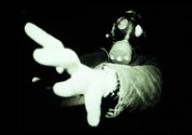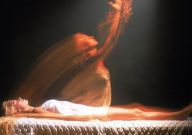Skeptics and believers alike, nothing gets people talking and debating like a good old urban legend or ghost story. What’s even better, is when there is no definitive answer as to whether the event happened or not, and why. Here at Paranormala, this is our modus operandi.. to bring to you, our beloved reader the most interesting and sometimes ridiculous unexplained phenomena.
So without further ado, here is the first half of our favorite unexplained, mysterious and just plain weird happenings:
10. The Klerksdorp Spheres
Much debate has arisen over the origin of these small, spherical or disc shaped objects found near Ottosdal, South Africa. Alternative researchers and reporters claim these are “anomalous, out of place artifacts” and had to have been developed by intelligent beings, either human, or of alien origin.

A Grooved Klerksdorp Sphere
Geologists rebut that these little nuggets of weirdness are a result of natural processes, coming from 3.0 billion year old pyrophyllite deposits.
Whatever the case may be, these grooved spheres are monumentally interesting artifacts.
9. Angel Hair
There are a number of accounts of this fiberous substance observed to have fallen from the sky, often believed to be a result of UFO phenomenon. An interesting account reported by USA Today and the AP details twenty UFOs seen over Quirindi, New South Wales, Australia, dropping down Angel Hair on the ground as they passed. It is said that any attempt at collecting it results in the material completely subliming and disappearing.

An Illustration Of Angel Hair From UFOs
It should be noted that Angel Hair has also, appropriately been associated with sightings of angels.
8. The Dropa Stones
The Dropa, according to legend, are a race of dwarf-like extraterrestrials that purportedly inhabited the Baian-Kara-Ula mountains of China. A 1938 archeological expedition led by Dr. Chi Pu Tei into this region led to the discovery of a series of artificially carved caves containing the Dropa Stones.
Each stone, or disc rather, is said to be around 12,000 years old, roughly 9 inches in diameter, has a small whole cut in the center and is etched with a spiral pattern of hieroglyphics. It gets weirder. The hieroglyphics apparently tell a tale of the Dropa coming from outer space and crash landing in the mountains. Allegedly, Dr. Chi Pu Tei’s team also found several neat rows of tombs with 4 ft 4 inch skeletons, big classic alien heads and all, buried inside them.

Photo of the Alleged Dropa Stone Discs
Historical evidence or hoax, the Dropa stones are of great interest to researchers and skeptics alike.
7. The Miracle of the Sun
The Miracle of the Sun is an alleged miraculous event witnessed by 30,000 to 100,000 people in 1917 near Fatima, Portugal. Many sources attempt to explain the event using known phenomena such as clouds, stratospheric dust, or a “sundog“, but it is most often associated with biblical “endtime” prophecies and UFO lore.

A Newspaper Scan Showing Fatima Viewers
Here is a summary of events from Wikipedia:
“According to many witness statements, after a downfall of rain, the dark clouds broke and the sun appeared as an opaque, spinning disk in the sky. It was said to be significantly less bright than normal, and cast multicolored lights across the landscape, the shadows on the landscape, the people, and the surrounding clouds. The sun was then reported to have careened towards the earth in a zigzag pattern, frightening some of those present who thought it meant the end of the world. Some witnesses reported that their previously wet clothes became “suddenly and completely dry.”
Estimates of the number of witnesses range from 30,000-40,000 by Avelino de Almeida, writing for the Portuguese newspaper O Século, to 100,000, estimated by Dr. Joseph Garrett, professor of natural sciences at the University of Coimbra, both of whom were present that day.
The miracle was attributed by believers to Our Lady of Fátima, an apparition of the Blessed Virgin Mary to three young shepherd children in 1917, as having been predicted by the three children on 13 July, 19 August, and 13 September 1917. The children reported that the Lady had promised them that she would on 13 October reveal her identity to them and provide a miracle “so that all may believe.”
According to these reports, the miracle of the sun lasted approximately ten minutes. The three children also reported seeing a panorama of visions, including those of Jesus, the Blessed Virgin Mary, and of Saint Joseph blessing the people.”
6. Morgellons Disease
Morgellons Disease is an infectious condition where reported symptoms include crawling, biting, and stinging sensations; finding multi-colored fibers on or under the skin and persistent skin rashes or open sores.
The scientific community has all but shunned Morgellons sufferers, stating that Morgellons isn’t a new disorder, but instead a combination of known medical conditions, including delusional parasitosis.
Members of the Morgellons Research Foundation and several Morgellons patients have successfully gotten the U.S. government’s Centers for Disease Control and Prevention (the CDC) to investigate their condition.

According to Wikipedia: The CDC states that while it is not known at present whether the condition represents a new disease entity, or whether persons who identify themselves as having Morgellons have a common cause for their symptoms, share common risk factors, or are contagious, it has begun an epidemiological investigation of the “Unexplained Dermopathy”.
5. The Taos Hum
The Taos Hum is a mysterious low-frequency humming noise of unknown origin that reportedly exists in Taos, New Mexico. Other occurrences of this phenomena have been reported all over the world and most have been attributed to industrial sounds. What makes the Taos Hum interesting is that the hum is often intensified inside of buildings and is only heard by around 2% of the local population.
Generally, the Taos Hum is thought to be one of the following:
- Man-made noises (subwoofers, industrial machinery, etc)
- Infrasound from different possible sources, possibly geologic or plate tectonic in nature.
- Pulsed microwaves
- Electromagnetic waves caused by meteors
- Extremely low frequency communications systems (submarine communication, etc)
- Ionospheric heating systems (HAARP)
It should be noted however, that the source of the hum has not been identified, even after exhaustive research by local universities and hobbyists.
You can listen to a recording of the Taos Hum here.
4. Near Death Experiences

Ascent of the Blessed by Hieronymus Bosch
Is there an afterlife? Many individuals who have had a near death experience (NDE) believe so. Their experiences often leave them with newfound spirituality and religious belief, changing their lives forever.
Interestingly enough, a near death experience isn’t the same for everyone. Far from it actually, in most cases, a NDE any particular person experiences will reflect whatever religious beliefs that the person held.
From Wikipedia:
“Children, who typically do not have enough time to develop strongly towards one faith, had very limited NDEs. Examples of this include a boy simply having talked to his brother in his NDE and a daughter having a conversation with her mother. The phenomenology of an NDE usually includes physiological, psychological and alleged transcendental aspects. Typically, the experience follows a distinct progression:
- A very unpleasant sound/noise is the first sensory impression to be noticed (R. Moody: Life after Life);
- A sense of being dead;
- Pleasant emotions; calmness and serenity;
- An out-of-body experience; a sensation of floating above one’s own body and seeing the surrounding area;
- Floating up a blue tunnel with a strong, bright light or garden at the end;
- Meeting deceased relatives or spiritual figures;
- Encountering a being of light, or a light (often interpreted as being the deity or deities they personally believe in);
- Being given a life review;
- Reaching a border or boundary;
- A feeling of being returned to the body, often accompanied by a reluctance.
- Feeling of warmth even though naked.
The sometimes fantastic claims of those who have reported NDEs have not gone unchallenged. Most of the scientific community regards such experiences as hallucinatory and even sometimes completely fabricated.
While the paranormal community is somewhat more accepting of the NDE phenomenon, there is constant objective research into the field.
In September 2008, it was announced that 25 UK and US hospitals will examine near-death studies in 1,500 heart attack patients-survivors. The study will attempt to determine if people without heartbeat or brain activity can have an out-of-body experience with visual perceptions.
3. Doppelgangers
While often the work of fiction, Doppelgangers (and evil twins) do have some pretty interesting tales.
Here are a few famous historical accounts of Doppelgangers, evil twins and harbingers:
- Queen Elizabeth I reportedly saw herself lying pale and still on her bed, soon before she died.
- Johann Wolfgang von Goethe, is said to have seen his double wearing a gray suit, trimmed in gold, riding towards him in the opposite direction while on his way to Drusenheim. Eight years later, while riding from Drusenheim on the very same road, he realized he was wearing the exact outfit that he had seen on his double eight years earlier.
- Catherine the Great of Russia saw her own image coming toward her and became so frightened that she ordered her soldiers to fire upon it, which they did, but to no avail.

Abe Lincoln
Abe Lincoln, of all people, claimed to have witnessed himself with two faces in his mirror. Abe was pretty superstitious and old mirrors can be kind of tricky, but here is Honest Abe’s recount of the incident:
“ It was just after my election in 1860, when the news had been coming in thick and fast all day and there had been a great “hurrah, boys,” so that I was well tired out, and went home to rest, throwing myself down on a lounge in my chamber. Opposite where I lay was a bureau with a swinging glass upon it and looking in that glass I saw myself reflected nearly at full length; but my face, I noticed had two separate and distinct images, the tip of the nose of one being about three inches from the tip of the other. I was a little bothered, perhaps startled, and got up and looked in the glass, but the illusion vanished. On lying down again, I saw it a second time, plainer, if possible, than before; and then I noticed that one of the faces was a little paler — say five shades — than the other. I got up, and the thing melted away, and I went off, and in the excitement of the hour forgot all about it — nearly, but not quite, for the thing would once in a while come up, and give me a little pang as if something uncomfortable had happened. When I went home again that night I told my wife about it, and a few days afterward I made the experiment again, when (with a laugh), sure enough! The thing came back again; but I never succeeded in bringing the ghost back after that, though I once tried very industriously to show it to my wife, who was somewhat worried about it. She thought it was a “sign” that I was to be elected to a second term of office, and that the paleness of one of the faces was an omen that I should not see life through the last term.”
Somewhat in tune with the Universal Tricker (sometimes Universal Prankster), Doppelgangers are believed to provide their “twins” with misleading or malicious advice and sometimes are even thought to implant ideas in their minds. Thus, it is considered gravely unwise to attempt to communicate with one’s doppelganger.
2. The Sudarium of Oviedo
The Sudarium of Oviedo is a bloodstained cloth purported to have covered the head of Jesus after his burial. The 34″ by 21″ Sudarium is currently housed in the Cathedral of San Salvador, Oviedo, Spain. The cloth is not mentioned in accounts of the actual burial of Christ, but is mentioned as having been present in the empty tomb. It is also described as a cloth physically separate from yet another popular relic, The Shroud of Turin (which consists of the same material as the Sudarium).

The Sudarium of Oviedo
In an attempt to verify the authenticity of the Sudarium, an investigation of the stains by Dr. Jose Villalain showed that the victim died in an upright position, and the stains are comprised mostly of fluid from the lungs. This finding is consistent with crucifixion, which tends to suffocate the victim instead of causing death by blood loss, as commonly believed. Pollen samples taken from the cloth by Dr. Max Frei are consistent with Jerusalem, North Africa and Spain, all of which the Sudarium has been kept.
1. Black Triangle UFOs
One of the most regularly sighted UFOs is the Black Triangle UFO. The black triangle ufo is characterized as being totally silent in its flight despite being a very large, triangular craft hovering or slowly cruising at very low altitudes over cities and highways. They are often described as having bright lights on the underneath at each corner of the triangle. Sometimes a red pulsating light in the center is reported as well.
Triangle shaped UFOs have been reported regularly since the early 1940s. They are one of the most “social” UFO types, often being seen at night time over major population centers, thus explaining their frequent sightings. Due to the enormous amount of sightings in the US, many believe the craft to be a secret aircraft of the US military.

Artist's Concept of a typical black triangle object.
Source and This One


 Viper fish
Viper fish
 Fangtooth
Fangtooth
 Dragonfish
Dragonfish

 Angler
Angler
 Gulper Eel
Gulper Eel
 Giant Squid
Giant Squid
 Giant Isopod
Giant Isopod

 Coffinfish
Coffinfish
 Vampire squid
Vampire squid
 Long-nosed Chimaera
Long-nosed Chimaera






























